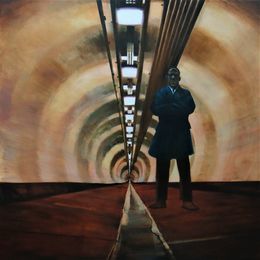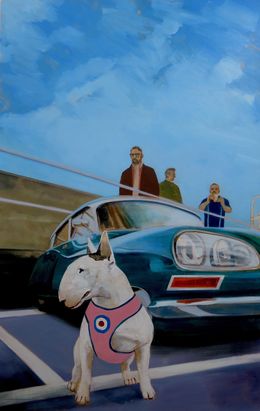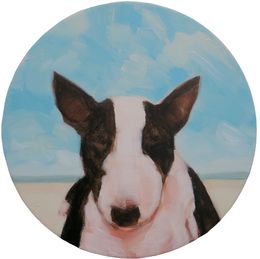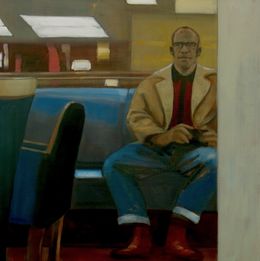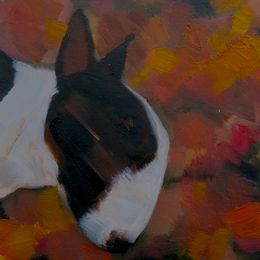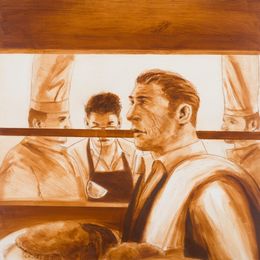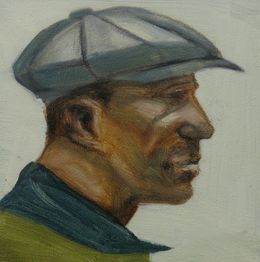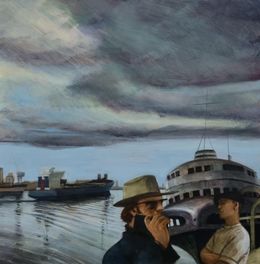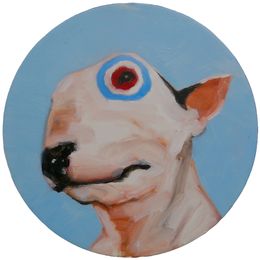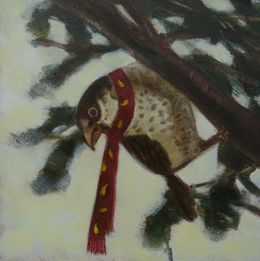This solo show of British painter Ray Richardson is entitled WALK TALL in reference to the heady tune by Cannonball Adderley, as an injunction to keep his head high up that unites the works featured.
Since the 1990s, Ray Richardson stages in an unique atmosphere his personal experience, his neighbourhood of Woolwich in South-East London, nerve center of his world that also includes places like the English coast, Normandy, Paris, Ostend, Brussels, New York, Chicago, Seattle, Los Angeles, Tokyo: "[My work]’s quite often about life, class as well as seeing it in a filmic way through a film still in my case. I think we’re riddled with class in England. They want to keep you in your place while mugging you off that you’ve got a chance, which a lot of people will never have."
Bordering the River Thames, this working-class suburb undergoing gentrification offers an authentic setting with its docks, the Woolwich ferry and the pedestrian tunnel that connects the two banks of the river, its car parks and its pubs. The history of the place is intertwined with that of its characters. It is a world of men with sideburns and brilliantined hairs, more or less cool, who like to swagger. In a pack, alone or with the iconic English Bull Terrier, "the King of Dogs", "the supreme K-9 kommanders", as written by James Ellroy in a text dedicated to the artist.
Ordinary life is a spectacle that Ray Richardson seems to extract from a film, transposing "a cinematic way of seeing things" in a great chromatic richness. Bold framing, long stretched formats, off-center characters, close-ups, high-angle or low-angle views energize the spatial organization of his compositions. His painting also draws on the tradition of art history, the immediacy of street photography, the darkness of detective novels, the Mod revival and Casual imagery, on a Jazz, Soul, Funk, Rock soundtrack.
He has a striking way with image and word. His titles mix popular expression, cockney slang and musical borrowing to better trigger a spark, an emotion, a questioning, a narrative tension... Ray Richardson's work is literally full of imagery, halfway between a description of a sociological microcosm, a sophisticated play on the codes of painting and a metaphorical reflection on the human condition. It shows as much as it underlies, sometimes in a very unexpected way, a funny or scathing commentary. WALK TALL deals with living together (Today's Special), the hope for better days (Herbie Hancock, Silver Linings, Double Treble Top), the need to be satisfied with one's condition (Sailors Fighting in the Dancehall, Vivre pour vivre), the work of painting (Performancedup, Same Meat Different Gravy, All Around the World). As more disillusioned reflections on the British class system: Just Got Lucky evokes the lottery of birth, Out to Lunch the gap between the bourgeois world and the working class, The Man Who Wouldn't Be King the increasing difficulty for ordinary people to get ahead by other ways than boxing, football, showbiz or worse.
Walk tall as "the King of Dogs", the alter ego of the painter and the voice of reason in a world that is missing it. A working class hero is something to be.
Born in 1964 in England, Ray Richardson lives and works in Woolwich (London). Graduated from Central Saint Martins (1984) and Goldsmiths (1987), he quickly stood out by winning his first British Council Award in 1989 and a BP Portrait Award the following year for his paintings of South-East tough guys that has earned him the nickname of "Martin Scorsese of figurative painting". From the 1990s onwards, he exhibited regularly in the UK and Europe, and settled temporarily in Paris, Brussels, Chicago and Connecticut during the decade. His work increasingly moved towards personal and social concerns. In 2015, he was included in the group show Reality: Modern & Contemporary British Painting at the Walker Art Gallery in Liverpool, celebrating the vitality of British painting by bringing together its most influential artists of the last sixty years. His painting is part of numerous public and private collections: Victoria and Albert Museum, Ashmolean Museum in Oxford, Fondation Carmignac, The National Portrait Gallery, Ingram Collection, Ruth Borchard Collection, etc.
Read more



